Peugeot 308 2014 Owner's Manual
Manufacturer: PEUGEOT, Model Year: 2014, Model line: 308, Model: Peugeot 308 2014Pages: 400, PDF Size: 10.05 MB
Page 211 of 400
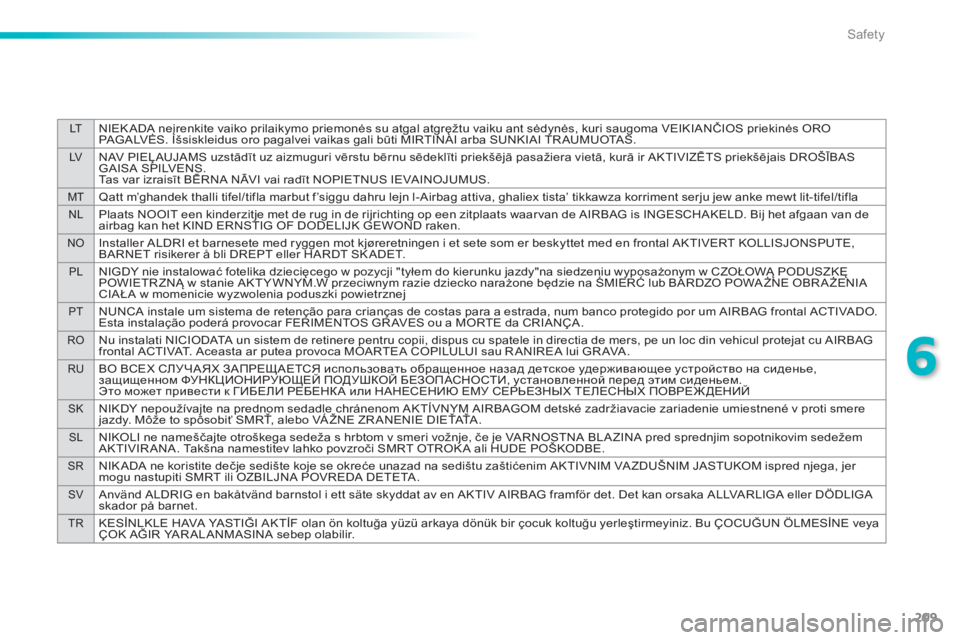
209
6
LTNIEK ADA neįrenkite vaiko prilaikymo priemonės su atgal atgręžtu vaiku ant sėdynės, kuri saugoma VEIKIANČIOS priekinės ORO
PAGALVĖS. Išsiskleidus oro pagalvei vaikas gali būti MIRTINAI arba SUNKIAI TR AUMUOTAS.
LVNAV PIEĻAUJAMS uzstādīt uz aizmuguri vērstu bērnu sēdeklīti priekšējā pasažiera vietā, kurā ir AKTIVIZĒTS priekšējais DROŠĪBAS
GAISA SPILVENS.
Tas var izraisīt BĒRNA NĀVI vai radīt NOPIETNUS IEVAINOJUMUS.
MTQatt m’ghandek thalli tifel/tifla marbut f’siggu dahru lejn l-Airbag attiva, ghaliex tista’ tikkawza korriment serju jew anke mewt lit-tifel/tifla
NLPlaats NOOIT een kinderzitje met de rug in de rijrichting op een zitplaats waar van de AIRBAG is INGESCHAKELD. Bij het afgaan van de
airbag kan het KIND ERNSTIG OF DODELIJK GEWOND raken.
NOInstaller ALDRI et barnesete med ryggen mot kjøreretningen i et sete som er beskyttet med en frontal AKTIVERT KOLLISJONSPUTE,
BARNET risikerer å bli DREPT eller HARDT SK ADET.
PLNIGDY nie instalować fotelika dziecięcego w pozycji "tyłem do kierunku jazdy"na siedzeniu wyposażonym w CZOŁOWĄ PODUSZKĘ
POWIETR ZNĄ w stanie AKT Y WNYM.W przeciwnym razie dziecko narażone będzie na ŚMIERĆ lub BARDZO POWA ŻNE OBR A ŻENIA
CIAŁA w momenicie wyzwolenia poduszki powietrznej
PTNUNCA instale um sistema de retenção para crianças de costas para a estrada, num banco protegido por um AIRBAG frontal ACTIVADO.
Esta instalação poderá provocar FERIMENTOS GR AVES ou a MORTE da CRIANÇA.
RONu instalati NICIODATA un sistem de retinere pentru copii, dispus cu spatele in directia de mers, pe un loc din vehicul protejat cu AIRBAG
frontal ACTIVAT. Aceasta ar putea provoca MOARTEA COPILULUI sau R ANIREA lui GR AVA.
RUВО ВСЕХ СЛУЧА ЯХ ЗАПРЕЩАЕТСЯ использовать обращенное назад детское удерживающее устройство на сиденье,
защищенном ФУНКЦИОНИРУЮЩЕЙ ПОДУШКОЙ БЕЗОПАСНОСТИ, установленной перед этим сиденьем.
Это может привести к ГИБЕЛИ РЕБЕНК А или НАНЕСЕНИЮ ЕМУ СЕРЬЕЗНЫХ ТЕЛЕСНЫХ ПОВРЕЖ ДЕНИЙ
SKNIKDY nepoužívajte na prednom sedadle chránenom AKTÍVNYM AIRBAGOM detské zadržiavacie zariadenie umiestnené v proti smere
jazdy. Môže to spôsobiť SMRŤ, alebo VÁ ŽNE ZR ANENIE DIEŤAŤA.
SLNIKOLI ne nameščajte otroškega sedeža s hrbtom v smeri vožnje, če je VARNOSTNA BLA ZINA pred sprednjim sopotnikovim sedežem
AKTIVIR ANA. Takšna namestitev lahko povzroči SMRT OTROK A ali HUDE POŠKODBE.
SRNIK ADA ne koristite dečje sedište koje se okreće unazad na sedištu zaštićenim AKTIVNIM VA ZDUŠNIM JASTUKOM ispred njega, jer
mogu nastupiti SMRT ili OZBILJNA POVREDA DETETA.
SVAnvänd ALDRIG en bakåtvänd barnstol i ett säte skyddat av en AKTIV AIRBAG framför det. Det kan orsaka ALLVARLIGA eller DÖDLIGA
skador på barnet.
TRKESİNLKLE HAVA YASTIĞI AKTİF olan ön koltuğa yüzü arkaya dönük bir çocuk koltuğu yerleştirmeyiniz. Bu ÇOCUĞUN ÖLMESİNE veya
ÇOK AĞIR YAR ALANMASINA sebep olabilir.
Safety
308_EN_CHAP06_SECURITE_ED02-2013
Page 212 of 400
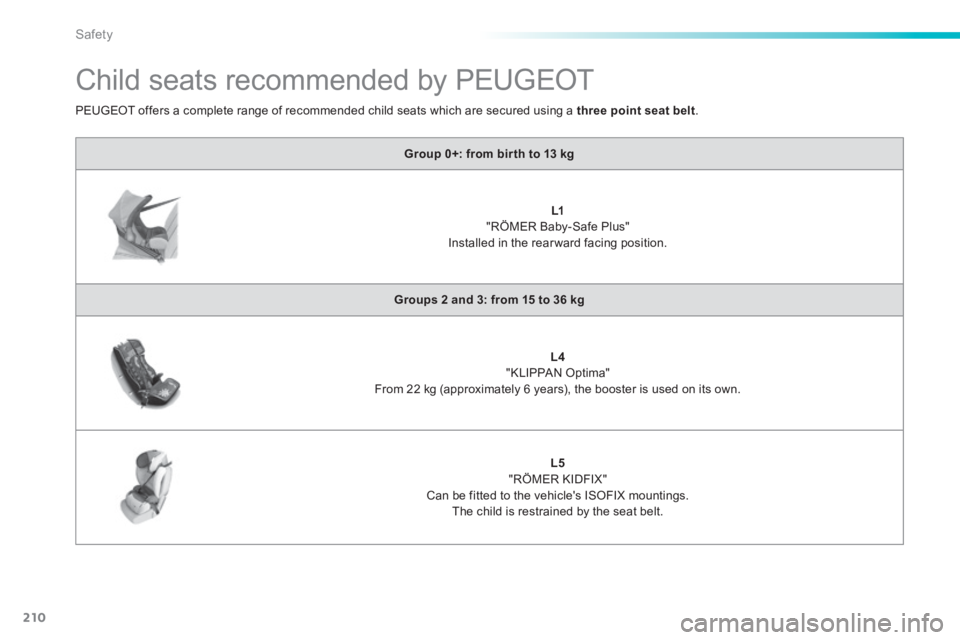
210
Safety
308_EN_CHAP06_SECURITE_ED02-2013
Child seats recommended by PEUGEOT
Group 0+: from bir th to 13 kg
L1
"RÖMER Baby-Safe Plus" Installed in the rear ward facing position.
Groups 2 and 3: from 15 to 36 kg
L4 "KLIPPAN Optima" From 22 kg (approximately 6 years), the booster is used on its own.
L5 "RÖMER KIDFIX" Can be fitted to the vehicle's ISOFIX mountings. The child is restrained by the seat belt.
PEUGEOT offers a complete range of recommended child seats which are secured using a three point seat belt .
Page 213 of 400
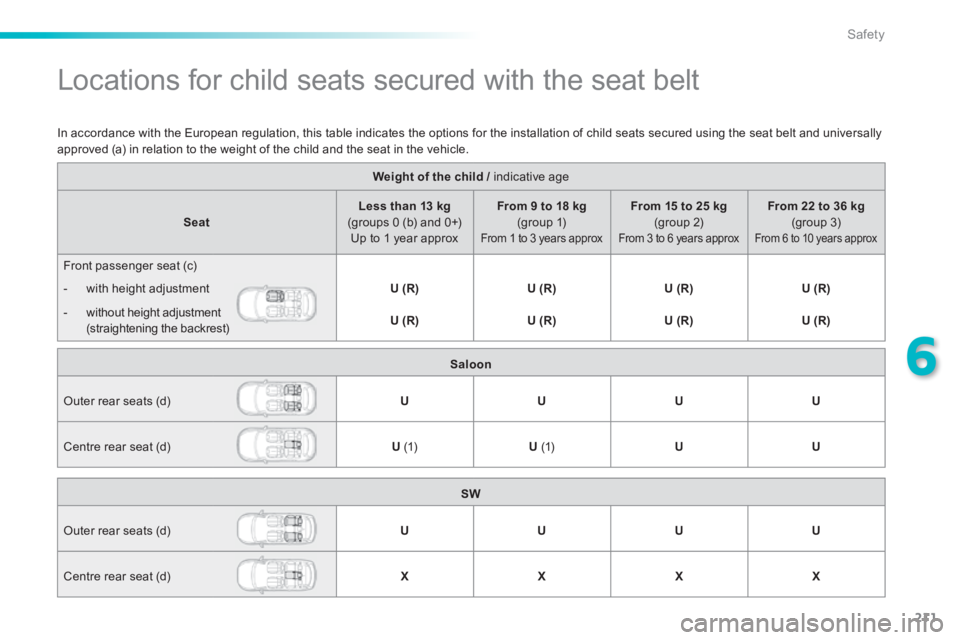
211
6
Safety
308_EN_CHAP06_SECURITE_ED02-2013
Locations for child seats secured with the seat belt
Weight of the child / indicative age Weight of the child / indicative age Weight of the child /
SeatLess than 13 kg (groups 0 (b) and 0+) Up to 1 year approx
From 9 to 18 kg (group 1) From 1 to 3 years approx
From 15 to 25 kg (group 2) From 3 to 6 years approx
From 22 to 36 kg (group 3) From 6 to 10 years approx
Front passenger seat (c)
- with height adjustment U (R)U (R)U (R)U (R)
- without height adjustment (straightening the backrest) U (R)U (R)U (R)U (R)
In accordance with the European regulation, this table indicates the options for the installation of child seats secured using the seat belt and universally approved (a) in relation to the weight of the child and the seat in the vehicle.
Saloon
Outer rear seats (d) UUUU
Centre rear seat (d) U (1) U (1) UU
SW
Outer rear seats (d) UUUU
Centre rear seat (d) XXXX
Page 214 of 400
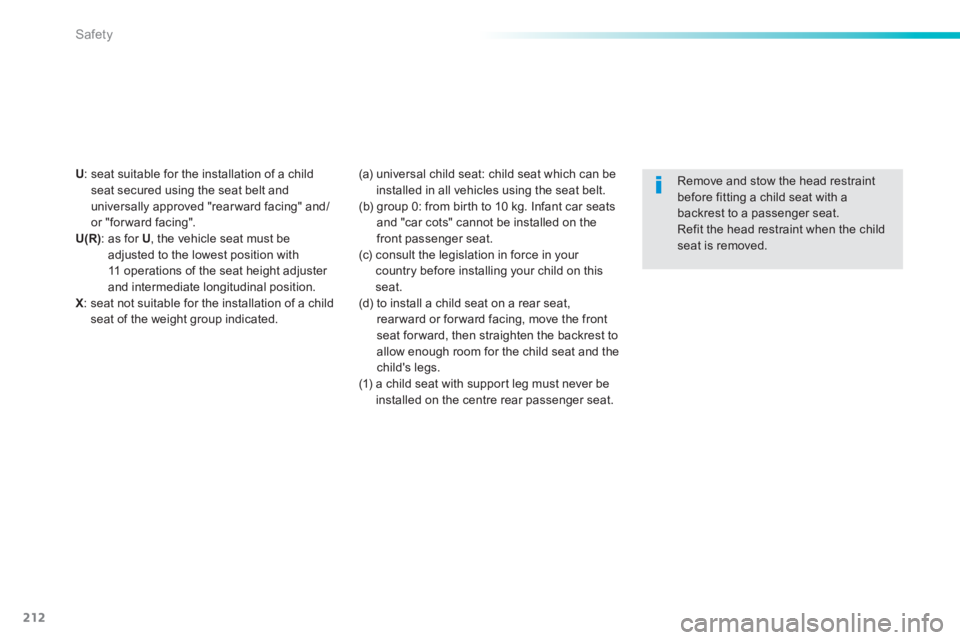
212
Safety
308_EN_CHAP06_SECURITE_ED02-2013
U : seat suitable for the installation of a child seat secured using the seat belt and universally approved "rearward facing" and/or "for ward facing". U(R) : as for U , the vehicle seat must be adjusted to the lowest position with 11 operations of the seat height adjuster and intermediate longitudinal position. X : seat not suitable for the installation of a child seat of the weight group indicated.
Remove and stow the head restraint before fitting a child seat with a backrest to a passenger seat. Refit the head restraint when the child seat is removed.
(a) universal child seat: child seat which can be installed in all vehicles using the seat belt. (b) group 0: from birth to 10 kg. Infant car seats and "car cots" cannot be installed on the
front passenger seat. (c) consult the legislation in force in your country before installing your child on this seat. (d) to install a child seat on a rear seat, rear ward or for ward facing, move the front seat for ward, then straighten the backrest to allow enough room for the child seat and the child's legs. (1) a child seat with support leg must never be installed on the centre rear passenger seat.
Page 215 of 400
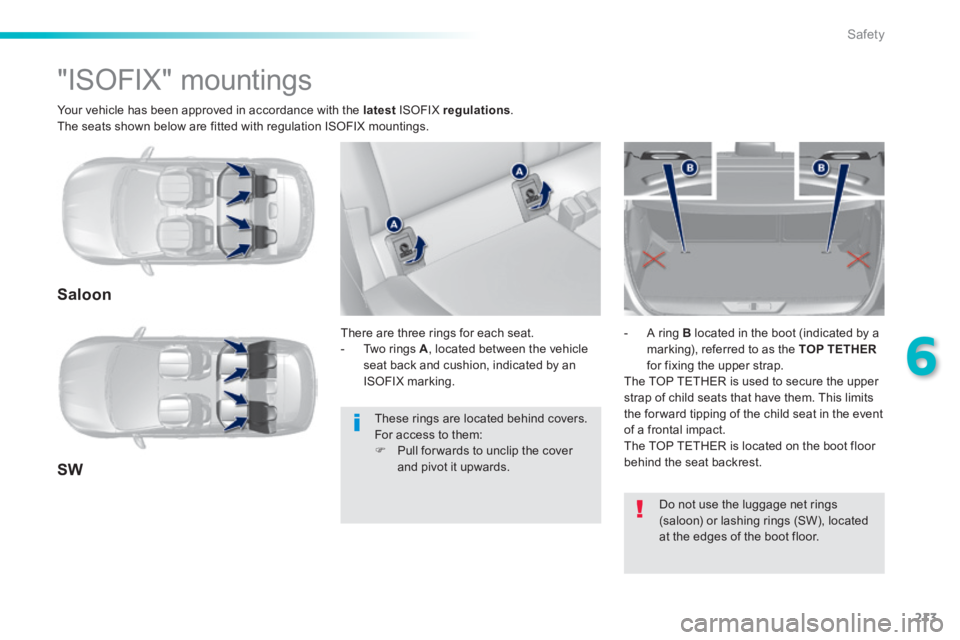
213
6
Safety
308_EN_CHAP06_SECURITE_ED02-2013
Your vehicle has been approved in accordance with the latest ISOFIX regulations . The seats shown below are fitted with regulation ISOFIX mountings.
"ISOFIX" mountings
There are three rings for each seat. - Two rings A , located between the vehicle seat back and cushion, indicated by an ISOFIX marking.
- A ring B located in the boot (indicated by a marking), referred to as the TOP TETHERfor fixing the upper strap. The TOP TETHER is used to secure the upper strap of child seats that have them. This limits the for ward tipping of the child seat in the event of a frontal impact. The TOP TETHER is located on the boot floor behind the seat backrest.
Do not use the luggage net rings (saloon) or lashing rings (SW), located at the edges of the boot floor.
These rings are located behind covers. For access to them: Pull for wards to unclip the cover and pivot it upwards.
Saloon
SW
Page 216 of 400
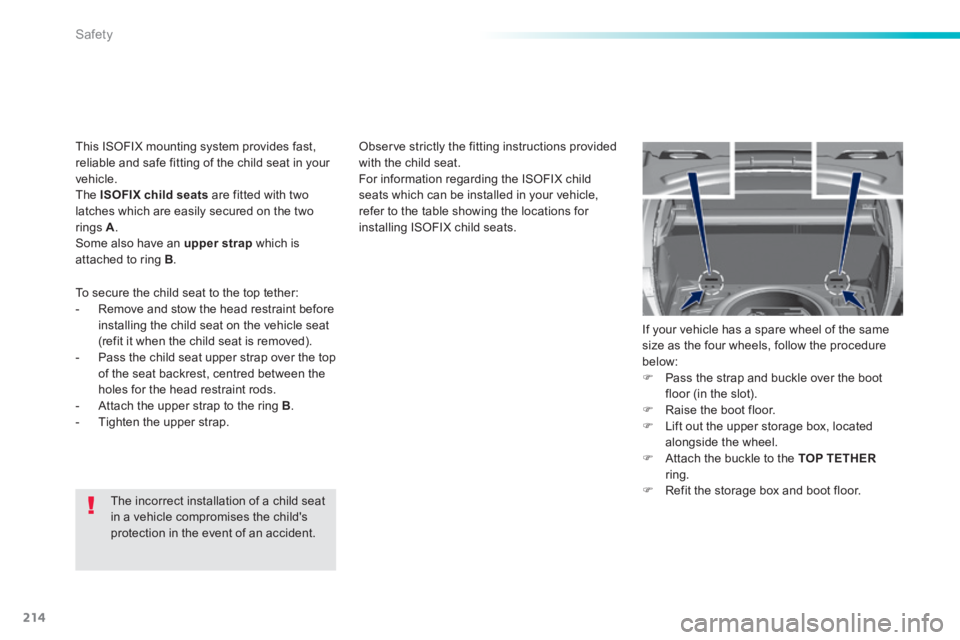
214
Safety
308_EN_CHAP06_SECURITE_ED02-2013
The incorrect installation of a child seat in a vehicle compromises the child's
protection in the event of an accident.
Observe strictly the fitting instructions provided with the child seat. For information regarding the ISOFIX child seats which can be installed in your vehicle, refer to the table showing the locations for
installing ISOFIX child seats.
To secure the child seat to the top tether: - Remove and stow the head restraint before installing the child seat on the vehicle seat (refit it when the child seat is removed). - Pass the child seat upper strap over the top of the seat backrest, centred between the holes for the head restraint rods. - Attach the upper strap to the ring B . - Tighten the upper strap.
If your vehicle has a spare wheel of the same size as the four wheels, follow the procedure below: Pass the strap and buckle over the boot floor (in the slot). Raise the boot floor. Lift out the upper storage box, located alongside the wheel. Attach the buckle to the TOP TETHERring. Refit the storage box and boot floor.
This ISOFIX mounting system provides fast, reliable and safe fitting of the child seat in your vehicle. The ISOFIX child seats are fitted with two latches which are easily secured on the two
rings A . Some also have an upper strap which is attached to ring B .
Page 217 of 400
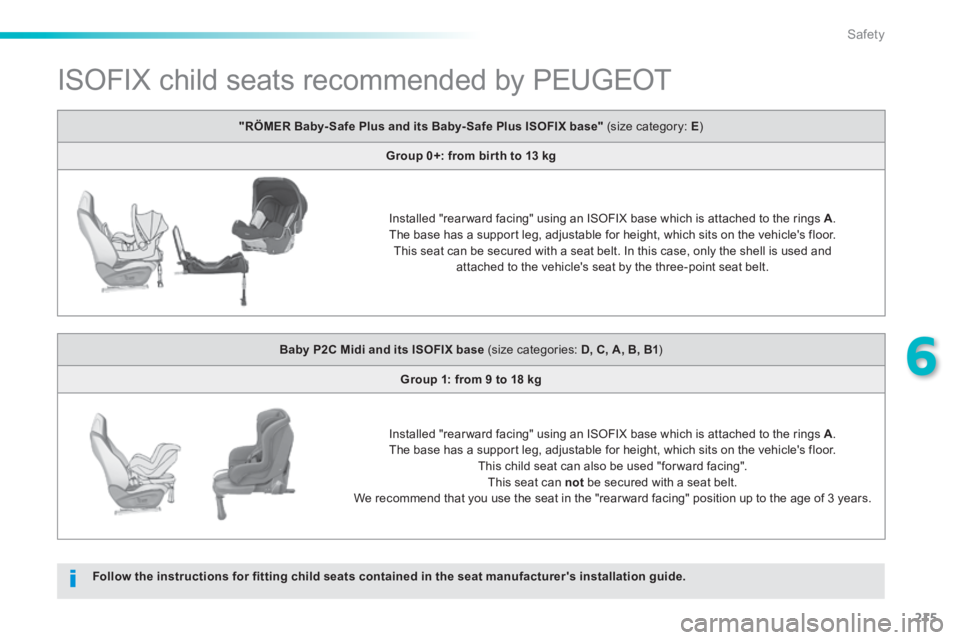
215
6
Safety
308_EN_CHAP06_SECURITE_ED02-2013
ISOFIX child seats recommended by PEUGEOT
Follow the instructions for fitting child seats contained in the seat manufacturer's installation guide.
"RÖMER Baby- Safe Plus and its Baby- Safe Plus ISOFIX base" (size category: E )
Group 0+: from bir th to 13 kg
Installed "rear ward facing" using an ISOFIX base which is attached to the rings A .
The base has a support leg, adjustable for height, which sits on the vehicle's floor. This seat can be secured with a seat belt. In this case, only the shell is used and attached to the vehicle's seat by the three-point seat belt.
Baby P2C Midi and its ISOFIX base (size categories: D, C, A, B, B1 )
Group 1: from 9 to 18 kg
Installed "rear ward facing" using an ISOFIX base which is attached to the rings A .The base has a support leg, adjustable for height, which sits on the vehicle's floor. This child seat can also be used "for ward facing". This seat can not be secured with a seat belt. We recommend that you use the seat in the "rear ward facing" position up to the age of 3 years.
Page 218 of 400
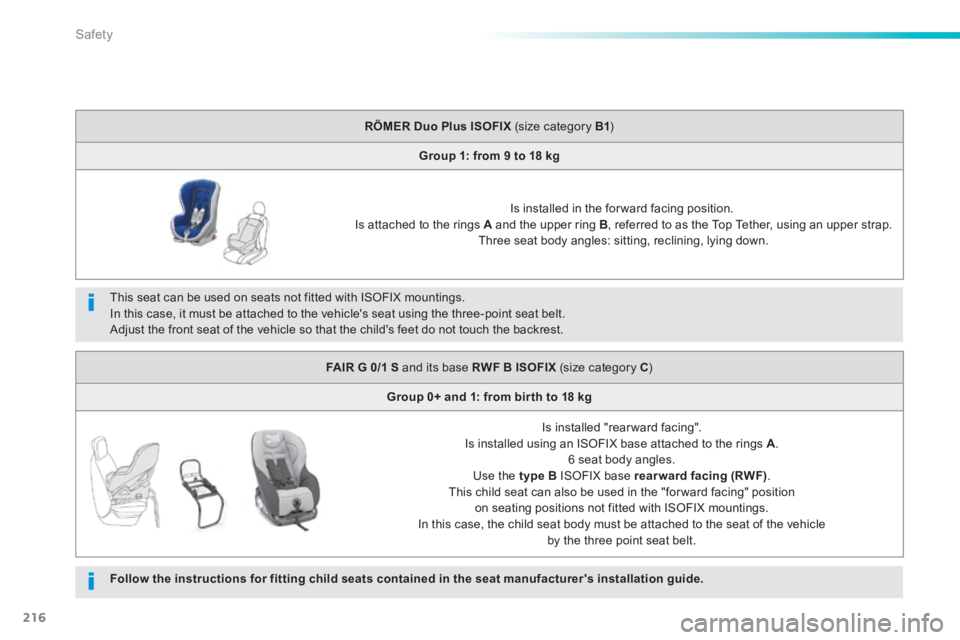
216
Safety
308_EN_CHAP06_SECURITE_ED02-2013
This seat can be used on seats not fitted with ISOFIX mountings. In this case, it must be attached to the vehicle's seat using the three-point seat belt. Adjust the front seat of the vehicle so that the child's feet do not touch the backrest.
RÖMER Duo Plus ISOFIX (size category B1 )
Group 1: from 9 to 18 kg
Is installed in the for ward facing position. Is attached to the rings A and the upper ring B , referred to as the Top Tether, using an upper strap. Three seat body angles: sitting, reclining, lying down.
FAIR G 0/1 S and its base RWF B ISOFIX (size category C )
Group 0+ and 1: from bir th to 18 kg
Is installed "rearward facing". Is installed using an ISOFIX base attached to the rings A . 6 seat body angles. Use the type B ISOFIX base rearward facing (RWF) . This child seat can also be used in the "for ward facing" position on seating positions not fitted with ISOFIX mountings. In this case, the child seat body must be attached to the seat of the vehicle by the three point seat belt.
Follow the instructions for fitting child seats contained in the seat manufacturer's installation guide.
Page 219 of 400
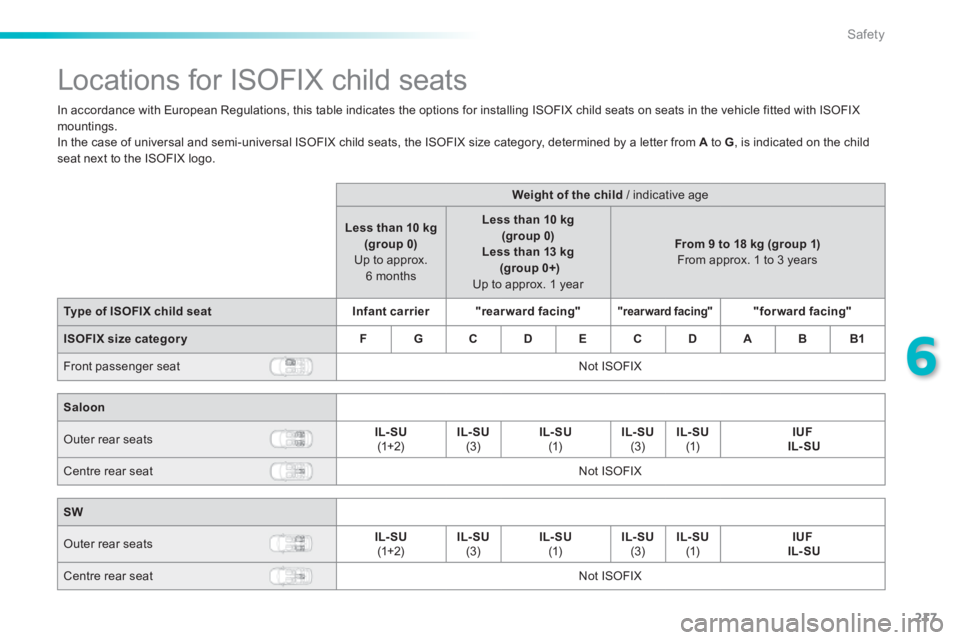
217
6
Safety
308_EN_CHAP06_SECURITE_ED02-2013
Locations for ISOFIX child seats
In accordance with European Regulations, this table indicates the options for installing ISOFIX child seats on seats in the vehicle fitted with ISOFIX mountings. In the case of universal and semi-universal ISOFIX child seats, the ISOFIX size category, determined by a letter from A to G , is indicated on the child seat next to the ISOFIX logo.
Weight of the child / indicative age
Less than 10 kg (group 0) Up to approx. 6 months
Less than 10 kg
(group 0) Less than 13 kg (group 0+) Up to approx. 1 year
From 9 to 18 kg (group 1) From approx. 1 to 3 years
Type of ISOFIX child seatInfant carrier"rearward facing""rearward facing""forward facing"
ISOFIX size categor yFGCDECDABB1
Front passenger seat Not ISOFIX
Saloon
Outer rear seats IL- SU (1+2) IL- SU (3) IL- SU (1) IL- SU (3) IL- SU (1) IUF IL- SU
Centre rear seat Not ISOFIX
SW
Outer rear seats IL- SU (1+2) IL- SU (3) IL- SU (1) IL- SU (3) IL- SU (1) IUF IL- SU
Centre rear seat Not ISOFIX
Page 220 of 400
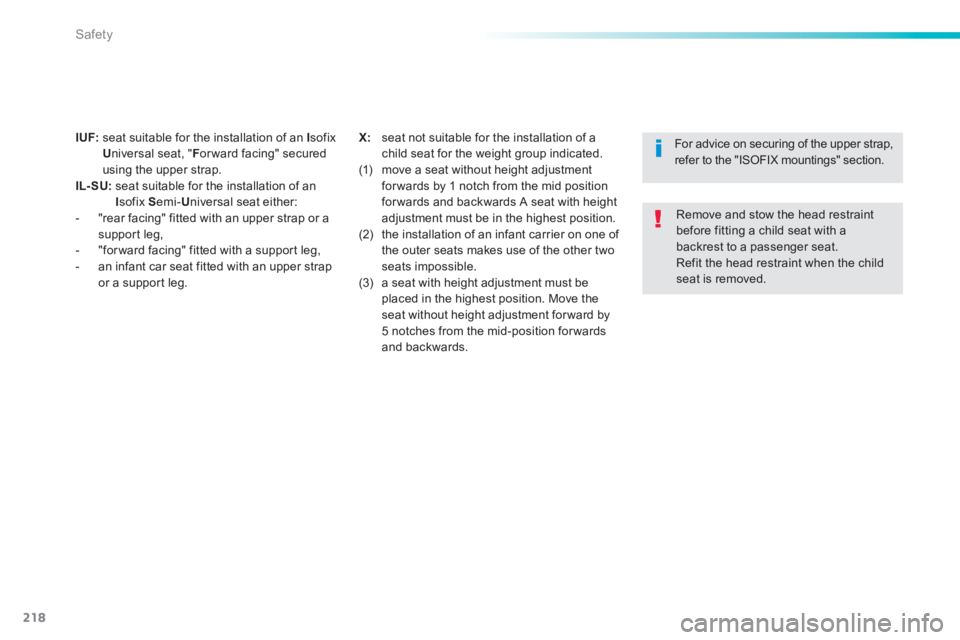
218
Safety
308_EN_CHAP06_SECURITE_ED02-2013
I UF: seat suitable for the installation of an I sofix U niversal seat, " F or ward facing" secured using the upper strap. IL- SU: seat suitable for the installation of an I sofix S emi- U niversal seat either: - "rear facing" fitted with an upper strap or a support leg, - "for ward facing" fitted with a support leg, - an infant car seat fitted with an upper strap or a support leg.
For advice on securing of the upper strap, refer to the "ISOFIX mountings" section.
X: seat not suitable for the installation of a child seat for the weight group indicated. (1) move a seat without height adjustment for wards by 1 notch from the mid position for wards and backwards A seat with height adjustment must be in the highest position. (2) the installation of an infant carrier on one of the outer seats makes use of the other two seats impossible. (3) a seat with height adjustment must be placed in the highest position. Move the seat without height adjustment for ward by 5 notches from the mid-position for wards and backwards.
Remove and stow the head restraint before fitting a child seat with a backrest to a passenger seat. Refit the head restraint when the child seat is removed.